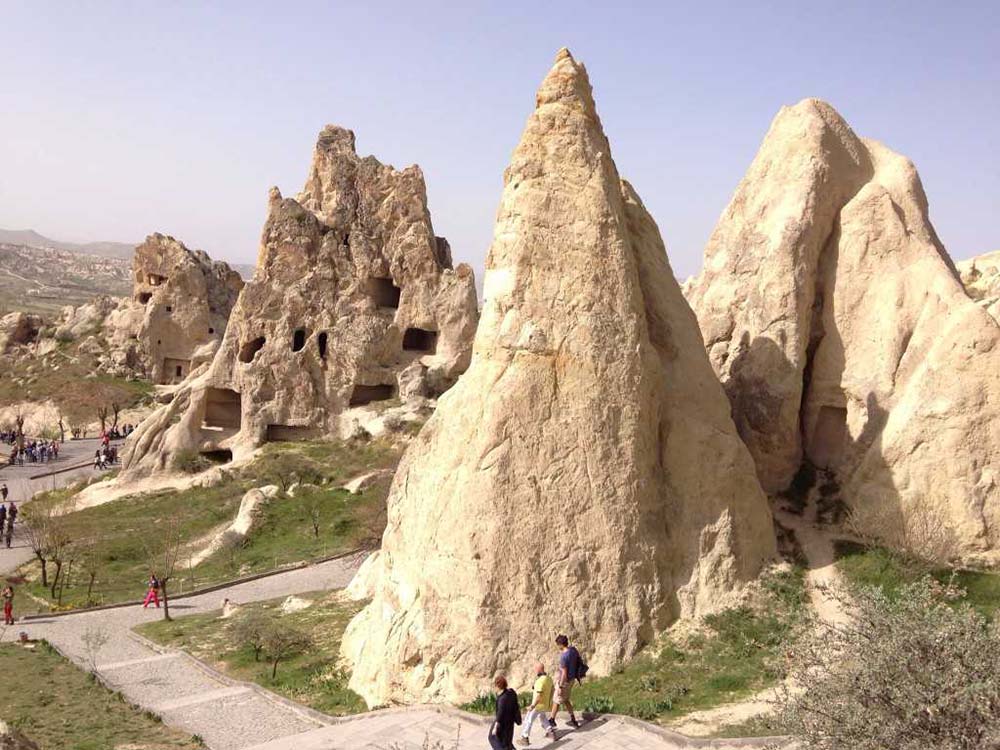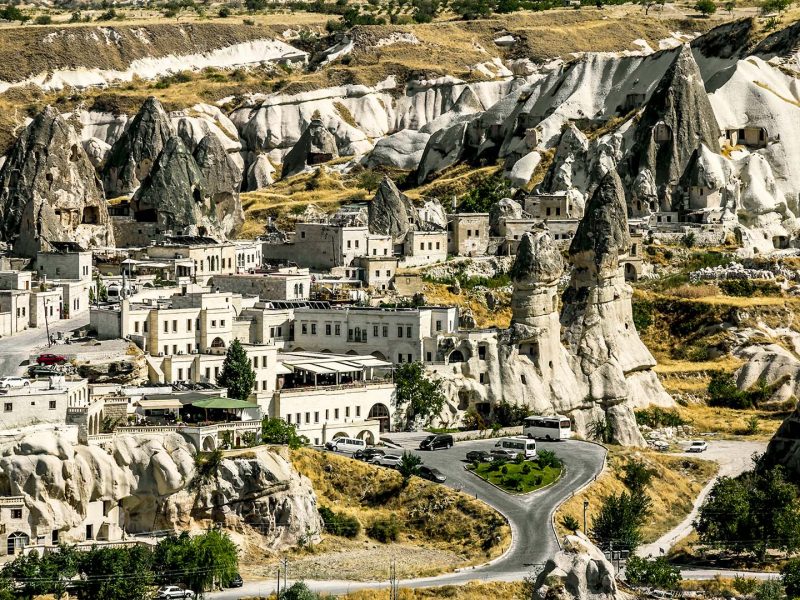Göreme, which is on the UNESCO World Heritage List, is well known for its cultural, historical, and natural beauty. If you want to see the fairy chimneys, you can explore this charming town of about 2,000 inhabitants. The Göreme Open Air Museum is one of the most popular places in Turkey. It is located approximately 2 kilometers away from the city center. The museum is at the start of a valley, which occurred as a result of natural phenomena. The story of this valley is based on the early periods of Christianity. Rumor has it that Bishop Saint Basil from Kayseri came to the region and started to spread what he knew, so that the hegemony began in this very region. In fact, this area was used as a center for educational systems until the 13th century.

Cappadocia and Göreme areas are famous with hot air balloon tours.
There are many chapels and churches in the area, where Saint Basil was inspired, and the monks wrote their opinions on the rocks. When we examine painting techniques of the churches, we can see that different eras exhibit different styles. When the first settlement and education started, paintings and the geometric designs of churches show us the structure of the communal life. In earlier periods, religious motifs were prevalent. Stories of Jesus and the Bible are told on frescoes. You can find here the texture and colors of those periods.
There is a nunnery at the first entrance of the museum which was used as a girls’ school in old times. There are cafes, churches, chapels, and kitchens inside the 7-floor building. It is thought that one could pass between floors via tunnels. You will also see a priesthood monastery in front of the nunnery, and this was used as a boys’ school. In time, tunnels between floors were destroyed by natural elements. Today, you can visit only a few rooms here.

Göreme, which is on the UNESCO World Heritage List, is well known for its cultural, historical, and natural beauty.
There are usually large rock blocks at the entrances to the valleys in the Göreme region. Most of these blocks have been carved and used for different purposes. Visiting began only after the region was transformed into a museum. There is St. Basil Chapel at the entrance of the museum. A chapel is a smaller church, and generally, chapels are made for private gatherings. There are graveyards as well. St. Basil Chapel is also a specially built area. The part at the entrance of the chapel, separated from the main part by columns, is called the “Narteks”, and important people’s graves are in this section. There are carved sections on graveyard. Rumor has it that, these sections were carved to symbolize a child’s grave. It is also thought that it was designed to emit a fragrance.
You will see a spectacular view after you leave the chapel. The Elmalı Church is another visiting stop that you come to in any season. You can get here by walking in a tunnel, but if you do not prefer tunnels, there is another way, it is just a longer walk. This church has particular views like art with its ornamentation and architectural details. The ceiling consists of nine domes and is supported by four columns. The reason it is called “Elmalı Church” is the that there is something like an apple (“Elma” in Turkish) in the painting of Archangel Michael. Do not be surprised if you see frescoes inside that look as good as new: these frescoes were all restored and preserved in the 1990s. However, some visitors have vandalized the frescoes by writing names on them.

There are many chapels and churches in the area, where Saint Basil was inspired, and the monks wrote their opinions on the rocks.
The Ave Barbara Church was built in the name of Egyptian Ave Barbara. Ave Barbara was murdered by her father because of her Christian faith. Thus, she is considered a martyr. There are depictions of saints and angels in the church. The Serpentine Church in Göreme Open Air Museum takes its name from St. George who was known to fight with the dragon. There is green dragon figure on the wall in the church and it resembles a serpent, so the name is Serpent Church. There are some interesting figures in the church, one of which is Saint Onuphrius which was drawn by a long-bearded and half-male and half-female body. Checkered decoration can be seen on the entrance gate of the Serpentine Church. In fact, this figure is not just an ornament; it has a story. When Jesus was crucified, his belongings could not be shared by the soldiers. When there was a problem with this, the Roman soldiers drew squares and put the items on the squares. The soldiers who were granted a shot slung stones to the squares. A soldier won the item on the square, that had been hit by his shot. Square figures are also depicted as symbols of this story.

Elmalı Church
The Serpent Church has also over time been used as a kitchen and a cellar. Today we know that there are stone ovens for baking bread in the villages. These ovens, named “tandır,” were used to cook in the churches many years ago. The original “kebab en cocotte,” the most popular of Turkish delicacies, is cooked in these tandoors.
The Dark Church in the museum is designed as a dome. This is a four-column church. The frescoes that decorate it narrate many biblical stories. Depicted images of the combination of the three fingers of Jesus represent the Holy Spirit-Father-Son trinity. You can see these symbols in the church.

